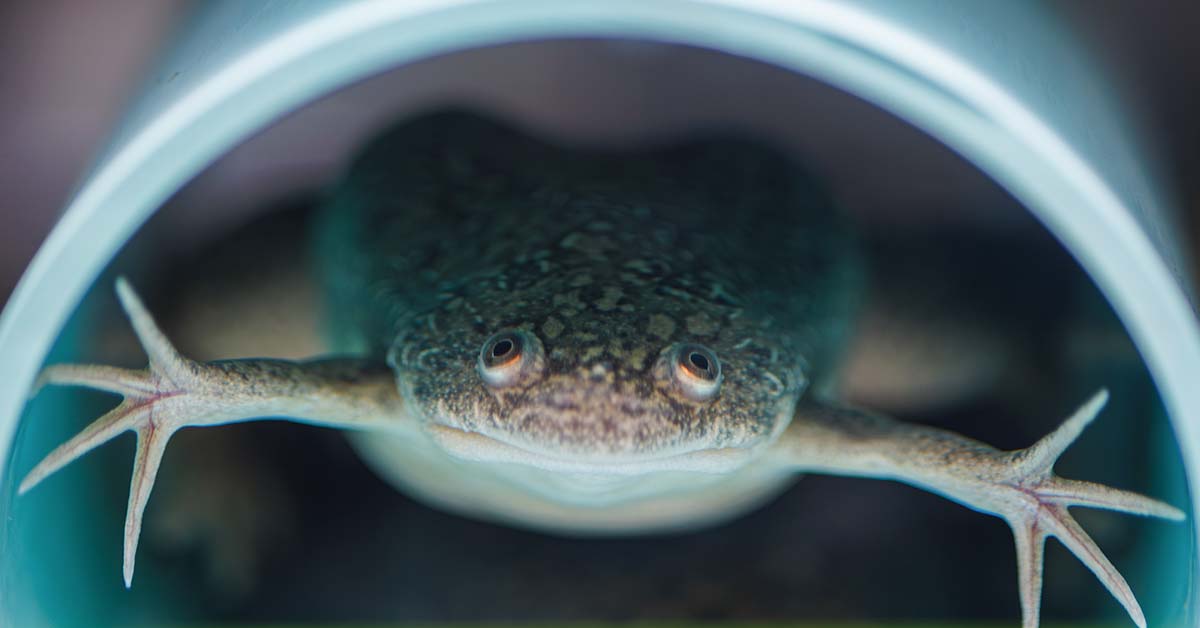Molecules too few and far between for standard cryo-EM
Cryo-EM suspends purified and concentrated molecules in a super thin layer of water on a metal mesh grid that is frozen so fast in liquid nitrogen that it resembles glass because crystals don’t have time to form.
A machine shoots an electron beam through the frozen sample to a detector that creates millions of two-dimensional images of the proteins captured from many different angles. A series of computer programs averages and sharpens all those snapshots to generate a three-dimensional image of the protein with near atomic-level resolution.
Early pioneers of cryo-EM won the Nobel Prize in chemistry in 2017, and Fred Hutch installed its own $4 million system in 2021.
To prepare a sample for cryo-EM, researchers must generate a lot of the protein they want to study, typically by growing it up in another living system such as bacteria, yeast, insect cells or mammalian cells.
They need a highly purified and concentrated sample because the blotting paper used to ensure the liquid layer is thin enough for the electron beam to pass through it soaks up most of the sample. Whatever liquid remains after blotting must contain enough concentrated protein to get an accurate image.
But the protein complexes Arimura derives from frog-generated chromatin are so few and far between that after blotting, the remaining sample is too diluted — by orders of magnitude — for standard cryo-EM algorithms to reconstruct the 3-D structure.
“I need to significantly reduce the sample size requirement to see the structure of the native chromatin,” Arimura said.
Solving that problem takes some magic — or rather, a tool Arimura invented called MagIC-cryo-EM, which makes it possible to study macromolecules in concentrations that are hundreds of times smaller than the thresholds typically required.
New methods make the most of tiny samples
At his previous job at Rockefeller University in New York, Arimura and his colleagues invented a new way to make the most of a small sample using nanobeads that are roughly 1,600 to 2,000 times smaller than the width of a human hair.
The nanobeads are linked to the protein complexes they want to study by a chain of molecules with intriguing names such as SPYcatcher and SPYtag.
The chain includes a spacer molecule that keeps a bit of distance between the nanobead and the target protein complex to make sure the cryo-EM gets distinct images uncluttered by the beads.
To prepare a sample for cryo-EM, Arimura mixes a solution with the nanobeads, tether molecules and frog-made chromatin, which grabs the protein complexes he wants to study and tethers them to the beads.
The next trick is to tow the tethered sample into position on the cryo-EM grid, the part that the electron beams shoot through to get the image.
The grid is a fine gold mesh, about 3 millimeters in diameter, with about 100,000 holes where the sample is captured in a layer of thin ice.
Arimura holds this little gold grid with special long tweezers, drops some of his solution on it, and then suspends the square over powerful neodymium magnets for five minutes as if he were roasting marshmallows over a campfire.
The nanobeads respond to the magnetic field, which pulls the beads — and their tethered cargo — out of the solution and onto the grid, even though the grid itself isn’t magnetic.
Think of it like a magnet under a table moving a paper clip on top of the table even though the table itself isn’t magnetic.
Once the nanobeads reach the grid with the sample in tow, other molecules coating the nanobead help it bind to the grid’s surface.
Arimura pulls about 250,000 magnetized nanobeads onto that tiny disk, which fill the holes of the grid with many more of his targeted protein complexes than would typically land there using conventional techniques.
The increased efficiency compensates for the wasted portion soaked up by the blotting paper.
Using the MagIC-cryo-EM method allows Arimura to use concentrations of target molecules that are 100 to 1,000 times smaller than the concentrations typically required for cryo-EM.
Arimura and his Rockefeller colleagues tested the system out on a particular set of red jellybeans they wanted to pull out of the bowl: a protein complex called a linker histone that helps organize the packaging of DNA.
Deep dives into the structure of small things
DNA strands wrap around histones, which are clustered into eight-histone balls called nucleosomes that are threaded like beads on a string into fibers that are further intertwined to form chromosomes.
A linker histone acts like a clamp that holds the string in place and tightens the wrapping.
Arimura and his colleagues used the MagIC-cryo-EM method to find the 3-D structure of a particular linker histone, H1.8, at two different points in the cell cycle of frog-made chromatin.
Arimura, Hironori Funabiki, PhD, and Hide Konishi, PhD, a postdoctoral researcher in Funabiki’s lab, described the results in a study recently published in the journal eLife.
They also solved another problem that arises during the computational averaging of millions of snapshots of a scarce and tiny molecule — some of those snapshots include extraneous particles that mask the target.
Arimura invented a method that excludes those fuzzy snapshots from the image the computer generates called Duplicated Selection To Exclude Rubbish particles, or DuSTER.
When they cleaned up the image with DuSTER, they revealed for the first time the structure of NPM2, a chaperone protein that helps H1.8 do its job of organizing chromatin during cell division as well as regulating the cell cycle and gene expression.
“This is an important new tool in the arsenal of single molecule biologists, permitting a deep dive into structure of native complexes,” according to an eLife assessment accompanying the study. “This work will be of high interest to a broad swathe of scientists studying native macromolecules present at low concentrations in cells.”

